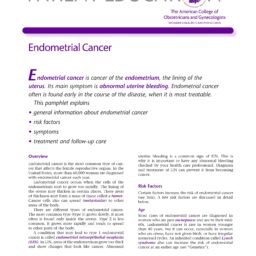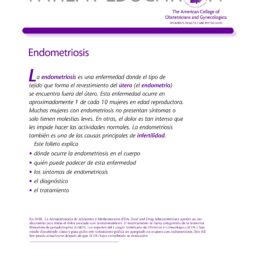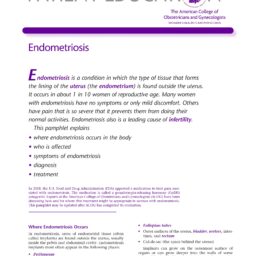Endometrial Health
Services: Endometrial
Endometrial Health
Endometriosis is a condition in which the type of tissue that forms the uterus lining (the endometrium) is found outside the uterus.
The most common symptom of endometriosis is chronic (long-term) pelvic pain, especially just before and during the menstrual period. Pain also may occur during sexual intercourse.
If it affects the bladder, there can be pain during urination. Heavy menstrual bleeding is another symptom of endometriosis.
Women without symptoms often learn they have endometriosis when they cannot get pregnant or have surgery for something else.

Endometriosis
What is Endometriosis?
Endometriosis is when the type of tissue that forms the uterus lining (the endometrium) is found outside the uterus. Endometriosis occurs in about 1 in 10 women of reproductive age. It is most often diagnosed in women in their 30s and 40s.
Endometriosis tissue responds to changes in a hormone called estrogen. The tissue may grow and bleed like the uterine lining does during the menstrual cycle. Surrounding tissue can become irritated, inflamed, and swollen. The breakdown and bleeding of this tissue each month also can cause scar tissue to form. This scar tissue is called adhesions. Sometimes adhesions can cause organs to stick together. The bleeding, inflammation, and scarring can cause pain, especially before and during menstruation.
Articles From Our WOmen's Health Library
| Thumb | Name | Size | Date |
|---|---|---|---|
 |
Endometrial-Cancer-PE-English.pdf
application/pdfEndometrial-Cancer-PE-English.pdf Open Download Copy Link 651.55 KB 2024-01-14 January 14, 2024 2024-01-07 January 7, 2024 |
651.55 KB | January 7, 2024 |
 |
Endometrial-Cancer-PE-Spanish.pdf
application/pdfEndometrial-Cancer-PE-Spanish.pdf Open Download Copy Link 659.33 KB 2024-01-14 January 14, 2024 2024-01-07 January 7, 2024 |
659.33 KB | January 7, 2024 |
 |
Endometrial-Hyperplasia-PE-English.pdf
application/pdfEndometrial-Hyperplasia-PE-English.pdf Open Download Copy Link 288.95 KB 2024-01-14 January 14, 2024 2024-01-07 January 7, 2024 |
288.95 KB | January 7, 2024 |
 |
Endometrial-Hyperplasia-PE-Spanish.pdf
application/pdfEndometrial-Hyperplasia-PE-Spanish.pdf Open Download Copy Link 293.38 KB 2024-01-14 January 14, 2024 2024-01-07 January 7, 2024 |
293.38 KB | January 7, 2024 |
 |
Endometriosis-Patient-Education-Spanish.pdf
application/pdfEndometriosis-Patient-Education-Spanish.pdf Open Download Copy Link 288.79 KB 2024-01-14 January 14, 2024 2024-01-07 January 7, 2024 |
288.79 KB | January 7, 2024 |
 |
Endometriosis-Patient-Education.pdf
application/pdfEndometriosis-Patient-Education.pdf Open Download Copy Link 278.45 KB 2024-01-14 January 14, 2024 2024-01-07 January 7, 2024 |
278.45 KB | January 7, 2024 |
6
- Symptoms
The most common symptom of endometriosis is chronic (long-term) pelvic pain, especially just before and during the menstrual period. Pain also may occur during sexual intercourse. If endometriosis affects the bowel, there can be pain during bowel movements. If it affects the bladder, there can be pain during urination. Heavy menstrual bleeding is another symptom of endometriosis.
Many women with endometriosis have no symptoms. Women without symptoms often learn they have endometriosis when they cannot get pregnant or have surgery for something else.
- Laparoscopy
Your provider first may do a physical exam, including a pelvic exam. But the only way to tell for sure that you have endometriosis is through a surgical procedure called laparoscopy. Sometimes, a small amount of tissue is removed and tested in a lab during the process.
- Recovery
What should I expect during recovery?
If you have a colposcopy without a biopsy, you should feel fine right away. You can do the things you usually do. You may have a minor spotting for a couple of days.
If you have a colposcopy with a biopsy, you may have pain and discomfort for 1 or 2 days. Over-the-counter pain medications can be helpful. You may have some vaginal bleeding. You also may have a dark discharge for a few days. This may occur from medication used to help stop bleeding at the biopsy site. You may need to wear a sanitary pad until the discharge stops.
Your ob-gyn may suggest you limit your activity for a brief time. While the cervix heals, you will be told not to put anything into your vagina for a short time. Follow these guidelines:
- Do not have sex.
- Do not use tampons.
- Do not douche.
- Treatment
Treatment for endometriosis depends on the extent of the disease, your symptoms, and whether you want to have children. Endometriosis may be treated with medication, surgery, or both. When pain is the primary problem, medication usually is tried first.
- Surgery Options
After surgery, most women have relief from pain. But there is a chance the pain will come back. Up to 8 in 10 women have pain again within two years of surgery. This may be due to endometriosis that was not visible or could not be removed at the time of surgery. The more severe the disease, the more likely it is to return. Taking birth control pills or other medications after having surgery may help extend the pain-free period.
- Patient Education
Endometrial Hyperplasia
What is Endometrial Hyperplasia?
When the endometrium, the lining of the uterus, becomes too thick, it is called endometrial hyperplasia. This condition is not cancer, but it can lead to cancer of the uterus in some cases.
Endometrial hyperplasia most often is caused by excess estrogen without progesterone. If ovulation does not occur, progesterone is not made, and the lining is not shed. The endometrium may continue to grow in response to estrogen. The cells that make up the lining may crowd together and become abnormal. This condition, called hyperplasia, can lead to cancer.
- Symptoms
The most common sign of hyperplasia is abnormal uterine bleeding. If you have any of the following, you should see your obstetrician-gynecologist (ob-gyn):
- Bleeding during your period that is heavier or lasts longer than usual
- Menstrual cycles that are shorter than 21 days (counting from the first day of the menstrual period to the first day of the next menstrual period)
- Any bleeding after menopause
- Prevention
You can take the following steps to reduce the risk of endometrial hyperplasia:
- If you take estrogen after menopause, you also need to take progestin or progesterone.
- If your periods are irregular, birth control pills may be recommended. They contain estrogen along with progestin. Other forms of progestin also may be taken.
- If you are overweight, losing weight may help.
- Types
When the endometrium, the lining of the uterus, becomes too thick, it is called endometrial hyperplasia. This condition is not cancer, but it can lead to cancer of the uterus in some cases.
Doctors describe endometrial hyperplasia based on the type of cell changes in the uterine lining. There are three categories:
- Benign endometrial hyperplasia—cell changes in the lining that are not cancer
- Endometrial intraepithelial neoplasia (EIN)—precancerous changes in the lining
- Endometrial adenocarcinoma, endometrioid type, well-differentiated—cancerous changes in the lining
- Non-Surgical Treatment
In many cases, endometrial hyperplasia can be treated with progestin. Progestin is given orally, in a shot, in an intrauterine device (IUD), or as a vaginal cream. How much and how long you take it depends on your age and the type of hyperplasia. Treatment with progestin may cause vaginal bleeding like a period.
If you have EIN changes in the lining, cancer risk is increased. Hysterectomy may be a treatment option if you do not want another pregnancy. Talk with your ob-gyn about the proper treatment for you.
- Surgery Options
Hysterectomy may be a treatment option if you do not want another pregnancy. Talk with your ob-gyn about the right treatment for you.
- Patient Education
- List Item
Endometrial Cancer
What is Endometrial Cancer?
Endometrial cancer is cancer of the endometrium, which is the uterus lining. It is the most common type of cancer that affects the female reproductive organs. The most common type of endometrial cancer (type 1) grows slowly. It most often is found only inside the uterus. Type 2 is less common. It grows more rapidly and tends to spread to other body parts.
Endometrial cancer occurs when the endometrium cells start to grow too rapidly. The lining of the uterus may thicken in certain places. These areas of thickness may form a mass of tissue called a tumor. Cancer cells can also spread (metastasize) to other body areas.
- Symptoms
Most women with endometrial cancer have early symptoms. The most common sign of endometrial cancer is abnormal uterine bleeding. This includes irregular menstrual bleeding, spotting, and bleeding between menstrual periods for premenopausal women. For postmenopausal women, any bleeding is uncommon. Symptoms of advanced endometrial cancer include abdominal or pelvic pain, bloating, feeling full quickly when eating, and changes in bowel or bladder habits.
- Diagnosis
There are no screening tests to detect endometrial cancer in women with no symptoms. If you are postmenopausal, any abnormal bleeding needs to be checked. You may first have a transvaginal ultrasound exam. During this exam, the thickness of the endometrium and the size of the uterus are measured. A thickened endometrium (more than 4 mm) means more testing is needed.
The standard way that endometrial cancer is diagnosed is with an endometrial biopsy. In this procedure, a sample of the endometrium is removed and looked at under a microscope. This test may be performed in your gynecologist’s office. Another way the endometrium can be sampled is with dilation and curettage (D&C). A lighted instrument with a camera called a hysteroscope may be used to help guide this procedure. Anesthesia is given to make you more comfortable.
If you are premenopausal, your gynecologist will consider your signs and symptoms, age, and other medical factors to decide whether a biopsy is needed. An ultrasound exam is not helpful if you are premenopausal in diagnosing endometrial cancer.
- Recovery
You will need to have regular health care visits after treatment for endometrial cancer. The purpose of these visits is to make sure that you stay healthy. However, 90% of women with stage I disease will have no sign of cancer five or more years after treatment.
A healthy lifestyle is recommended after cancer treatment. Several studies have found that obesity, high blood pressure, and diabetes can contribute to long-term health risks for type 1 endometrial cancer women. A healthy diet and regular exercise can help lower these risks.
- Surgery Options
After surgery, most women have relief from pain. But there is a chance the pain will come back. Up to 8 in 10 women have pain again within two years of surgery. This may be due to endometriosis that was not visible or could not be removed at the time of surgery. The more severe the disease, the more likely it is to return. Taking birth control pills or other medications after having surgery may help extend the pain-free period.
- Non-Surgical Treatment
Treatment with progestin is an option for women who want to have more children or women who cannot have surgery because of other medical reasons. This option usually is only recommended for women who:
Have slower-growing cancer that has not reached the muscle layer of the uterus
Do not have cancer outside of the uterus
They are in general good health and can take progestin
Understand that information about future outcomes is limited
For some women, it may be possible to keep the ovaries at the time of surgery. Keeping your ovaries means that you may be able to use your eggs for in vitro fertilization (IVF). This choice is not for everyone and is best made in consultation with your health care team.
- Surgery Options
Endometrial cancer usually is treated with surgery. During surgery, the cervix and uterus are removed (total hysterectomy) and both ovaries and fallopian tubes (salpingo-oophorectomy). Lymph nodes and other tissue may be removed and tested to determine if they contain cancer.
After surgery, the stage of the disease is determined. Staging helps your doctor decide if additional treatment, such as chemotherapy or radiation therapy, is needed—stages of cancer range from I to IV. Stage IV is the most advanced. The stage of cancer affects the treatment and outcome.
Our entire team is dedicated to you
We Help You Navigate Healthcare Decisions With Confidence
We Have Decades of Medical Experience and Providing Compassionate Care.

TEstimonials
What Our Patients Say
What an exceptional experience! I have never been to a nicer medical office. Ever! I was let called in after a second of completing my check in and everyone was so very nice. I wish i knew the name of the assistant that answered all our questions, she was very nice and informative. Don’t hesitate ladies!
The staff and everyone I met on the care team were extremely warm, kind, and knowledgeable. Although visit times are short, they made sure to explain everything thoroughly and made sure I understood. Even though they spoke quickly (lots of info to share in a short 15 minute slot) I never felt rushed or dismissed. I highly recommend this location and especially Dawn.
